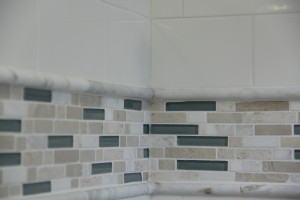How To Seal Tile and Grout

I’m a remodeling contractor in the Northeast and can tell you that most bathroom re-modeler do not take the time to seal tile grout for their customers.
We could debate why and I’ll probably point to a missing level of professionalism, ignorance, communication and cost but that’s for a different article. THIS article will focus on educating you on the proper techniques and information needed for sealing tile and grout.
Why Seal Non-glazed Tile and Grout?
The BIGGEST reason for sealing tile and grout, and especially grout, is to keep it looking clean and fresh. Non-sealed tile and grout gets grimy and stained over time and requires a lot of scrubbing and sometimes replacing to look good again.
Sealing tile and grout provides water and oil-based stain resistance and delays grout discoloration. Sealed tiles and grout stay cleaner longer and are much easier to clean.
What Tiles Need Sealing?
That answer is all unglazed tile, and any non-epoxy grout applications.
Unglazed porcelain tile and grout lines should be protected with a penetrating sealer. This type of tile has microscopic imperfections that will, over time, accumulate gunk and cause your floor to always look dirty.
Glazed tiles are coated with a liquid glass, which is backed into the surface of the tile. The glaze fills in the tiles microscopic imperfections, protects from stains and makes it an extremely durable surface. [Note – The cons to glazing is it can show wear over time.]
Is Sealing Tile and Grout A One Time Event?
No, unfortunately sealing tile and grout is a maintenance issue and needs to be done at a minimum every two years and sometimes sooner.
When To Apply Sealer
The best time to apply the first coat of sealer is 72 hours after the grout is installed.
After the initial application regular bi-yearly, or sooner if needed coats should be applied.
If you did not seal your tile when installed it is never too late. The tile and especially the grout will need to be thoroughly cleaned because applying sealer will lock in any stains or discoloration. In most situations, cleaning grout can be accomplished by using a bristle brush and simple dish soap. Badly stained grout may dictate a stronger cleaner or grout replacement.
Steps On Sealing Tile and Grout
1. Clean tile and grout thoroughly.
2. Ensure your tile and grout are dry
3. Mask off any areas you do not want to get sealer on.
3. Liberally apply a quality fluorochemical-based sealer to unglazed tile and non-epoxy grout.
4. Allow the sealer to penetrate for 5-120 minutes and apply a second coat. If sealer has dried on tile and a streaking is present use a “sealer dampened” towel to remove and then a dry towel to wipe clean.
5. Wipe off sealer with a clean, dry towel
6. Follow manufacturer directions for drying and usage.
7. Mark calendar for maintenance coat in 1-2 years
Sealing tile and grout will prolong the clean look and beauty of your tile installation. It provides a natural looking protective coating on interior and some exterior surfaces, and protects against water and oil-based stains.
Sealing Granite
Read my article and watch video on How to Seal Granite Counters
